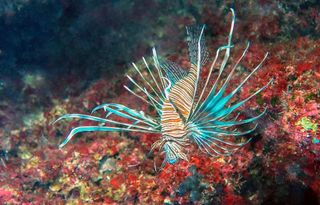Aliens Attack! Invasive Lionfish Arrive in Mediterranean

Venomous lionfish are striking to look at, with bold stripes and flowing, sail-like fins. However, scientists are paying especially close attention to the fish not for their beauty, but for their ability to invade ecosystems where they have no natural predators. The fish also tend to multiply in numbers that upset the balance of native biodiversity.
A new study shows that the first wave of a lionfish invasion has struck in the Mediterranean Sea, a region where these fish had not been established before.
Researchers gathered reports of lionfish sightings from fishermen and divers, discovering that in just one year, lionfish have colonized nearly all of Cyprus' southeastern coast, and that the animals' numbers are expected to grow. [Alien Invaders: Destructive Invasive Species]
"A reason to worry"
As ocean temperatures warm, numerous non-native fish have invaded Mediterranean waters — about 130 species since 2001, according to the study authors. The common lionfish (Pterois miles) recently detected in the Mediterranean is a close relative of the red lionfish (Pterois volitans). This notorious invasive species threatens reef ecosystems in coastal waters around the southeastern U.S. and in the Caribbean Sea.
According to study lead author Demetris Kletou, director of the Marine and Environmental Research Lab in Cypress, lionfish were first spotted in the Mediterranean in the 1990s. But sightings were few and far between, and there was no evidence suggesting that the animals were breeding successfully in the area, Kletou told Live Science in an email. In fact, it was suspected that the Mediterranean might not be a suitable habitat for dispersing lionfish larvae, the researchers reported in the study.
But recent observations suggest otherwise. Kletou and his colleagues compiled 24 new sightings of at least 19 individual fish, including mating pairs, which were seen in Mediterranean waters for the first time. That may not sound like much of an invasion, but lionfish can spawn every four days year-round, and can produce more than 2 million eggs per year. And with venomous spines to protect them, these opportunistic predators can quickly come to dominate a reef environment.
"When sightings become frequent and expand geographically, and when lionfish form reproductive groups, then it is a reason to worry," Kletou told Live Science.
Sign up for the Live Science daily newsletter now
Get the world’s most fascinating discoveries delivered straight to your inbox.
Sea-surface warming may be allowing the lionfish to expand their range, the researchers suggested. But recent work to expand the Suez Canal could also be playing a part, Kletou said. A wider and deeper canal increases the volume of flowing water that could carry lionfish larvae or swimming adults into the Mediterranean, Kletou explained. It would also affect the salinity of natural buffers like salt marshes, which can help keep invasive species out.
Related invaders
The runaway success of lionfish populations in waters around Florida could provide a glimpse into the future of Mediterranean habitats.
Lionfish were first detected in Florida waters during the 1980s and were recognized as an established invasive species in the 2000s, according to Amanda Nalley, a public information specialist with the Florida Fish and Wildlife Conservation Commission (FWC). The full extent of the species' impact on local ecosystems has yet to be determined, Nalley told Live Science. But, by preying on a variety of reef fish species, lionfish are reducing the number of fish that clean algae off coral reefs, she said. [Image Gallery: Catalogue of Strange Sea Creatures]
"If they're eating the fish that keep algae in check, that's going to be bad for the habitat," Nalley said.
She added that lionfish are proving to be highly adaptable, thriving in a range of water temperatures, depths and salinity levels. And unlike other successful invaders, like tiger shrimp, lionfish have no natural predators to keep populations under control. This has prompted the FWC to create initiatives and opportunities for divers, anglers and commercial harvesters to remove lionfish as part of seasonal competitions and year-round events. The initiatives urge participants to collect "as many as possible," Nalley said.
Increasing awareness
In the Mediterranean, the lionfish invasion is just getting started. But without oversight, Kletou warned, it could quickly escalate, with the fish expanding their presence, as other species have done, to become "another invasive failure story."
One such "failure" in the Mediterranean involves the pufferfish, also an invasive species. According to Kletou, pufferfish have disrupted food chains, replaced or over-predated native species and threatened local biodiversity.
Lionfish could also harm unsuspecting divers, Kletou said. Grabbing or accidentally touching one of the fish can result in painful stings from the animal's venomous spines.
However, lionfish are slow-moving and easy to collect — with proper precautions and equipment. The same local divers and fishermen who first noticed the lionfish could also provide a first line of defense against these invaders, Kletou told Live Science. Especially since lionfish are edible — once the venomous spines are removed.
"And they're quite tasty as well," he added.
The findings were published online June 30 in the journal Marine Biodiversity Records.
Original article on Live Science.

Mindy Weisberger is an editor at Scholastic and a former Live Science channel editor and senior writer. She has reported on general science, covering climate change, paleontology, biology and space. Mindy studied film at Columbia University; prior to Live Science she produced, wrote and directed media for the American Museum of Natural History in New York City. Her videos about dinosaurs, astrophysics, biodiversity and evolution appear in museums and science centers worldwide, earning awards such as the CINE Golden Eagle and the Communicator Award of Excellence. Her writing has also appeared in Scientific American, The Washington Post and How It Works Magazine. Her book "Rise of the Zombie Bugs: The Surprising Science of Parasitic Mind Control" will be published in spring 2025 by Johns Hopkins University Press.